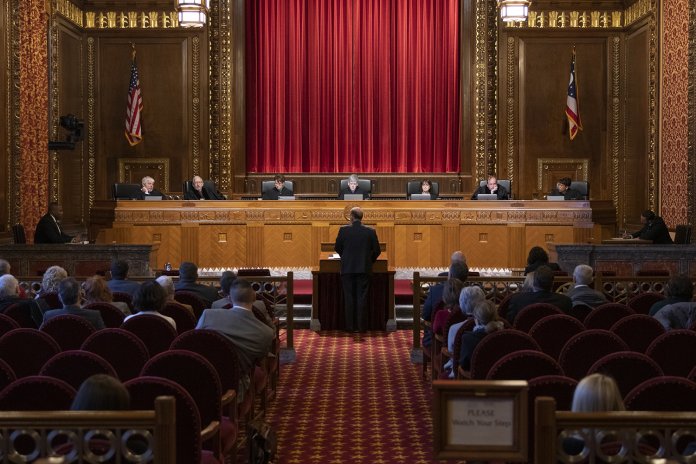BY NICK EVANS
Ohio Republicans may be lining up behind a constitutional amendment requiring judges to consider public safety when setting the amount of bail. The proposal is going before lawmakers as a joint resolution backed by Reps. Jeff LaRe, R-Violet Township, and D.J. Swearingen, R-Huron, in the House and Sen. Theresa Gavarone, R-Huron, in the Senate. They unveiled their effort alongside Attorney General Dave Yost and Hamilton County prosecutor Joseph Deters Tuesday.
DuBose vs. McGuffey
The core of their frustration is the state Supreme Court decision DuBose v. McGuffey. The majority in that case, made up of the court’s liberal wing plus outgoing chief justice Maureen O’Connor, sided with an appeals court that reduced DuBose’s bail. They pointed to judicial rules that draw a distinction between financial and non-financial conditions of release.
“Public safety is not a consideration with respect to the financialconditions of bail…” the majority wrote. “Public-safety concerns may be addressed by imposing nonfinancial conditions, such as restrictions on travel and association, completion of alcohol- and drug- abuse treatment, and orders of no contact with witnesses in the case.”
Yost contends that’s not good enough. He acknowledged the underlying logic of the court’s decision — presumption of innocence — is sound, but he argued the decision keeps judges from considering public safety when setting bail.
“The safety of the community is just as important as the defendant’s right to a fair trial and his presumption of innocence,” Yost said. “We do not serve one at the expense of the other. We need to do both.”
To get the proposal on the ballot, the lawmakers will need to get supermajority support in both chambers of the legislature. That already high bar could prove even more difficult to clear considering many lawmakers are already working on different, bipartisan bail reform measures in the House and Senate, H.B. 315 and S.B. 182.
On the other hand, Cleveland.com noted getting the measure on the ballot could help juice a high stakes Supreme Court race.
Stakeholder groups from across the political spectrum backing the earlier effort are voicing opposition to the constitutional amendment proposal.
“The narrative is frustrating that high dollar amount equals safe — it doesn’t,” Jeff Dillon from Americans for Prosperity explained.
In an emailed statement, ACLU of Ohio policy counsel Patrick Higgins chimed in to insist the DuBose decision “does not need fixing,” and the bipartisan proposals strike the right balance.
“They give judges and prosecutors the toolkit that they need to protect public safety, while honoring the presumption of innocence guaranteed to those accused of crimes,” he wrote.
Less safe today?
In arguing for the proposed amendment, Prosecutor Deters cited Justice Pat DeWine’s dissent in DuBose which stated Ohio is “less safe” because of the decision. He alluded to murder and rape cases to justify imposing high dollar bonds to “get dangerous people off the streets.”
In one hypothetical he referenced Oklahoma City bomber Timothy McVeigh.
“Honorably discharged veteran, no record and he kills all these people,” Deters said. “What’s the adequate bond for that? What do you what do you think that would be?”
Federal prosecutors argued for McVeigh to be held without bail and the judge agreed.
And prosecutors in Ohio can make the same case for pre-trial detention in cases like murder or first and second degree felonies. The bipartisan bail reform measure actually works to expand the list. But Deters argued that approach could have a chilling effect, because defense attorneys might question witnesses or victims during the bail hearing.
Deters also raised the example of Lonnell Anderson to make a post hoc argument for higher bail amounts. Deters argued Anderson shot and killed a man, but only because he had posted a $4,000 bond for a different weapons charge. Instead of asking the judge to deny bond once Anderson was charged with murder, prosecutors got his bail set at $1.5 million. That might seem insurmountable, but typically a defendant needs to provide 10% to a bail bondsman to secure their release.
Yost made an unsettling justification for their effort as well. Despite admitting some defendants don’t get a “fair shake” in court, he argued, “the number of charged people who are actually innocent is vanishingly small.”
To Micah Derry it all smacks of a worn-out approach to criminal justice. He’s the national bail reform coordinator for Arnold Ventures which is one of the groups lobbying on behalf of H.B. 315 and S.B. 182. He acknowledged the need for changes in Ohio’s bail system. But he argued emphasizing cash bail doesn’t actually increase safety and it raises costs.
“This would’ve been far more understandable if this were 1992,” he said of the constitutional amendment idea. “But in 2022, it feels old, rehashed and unimaginative.”





